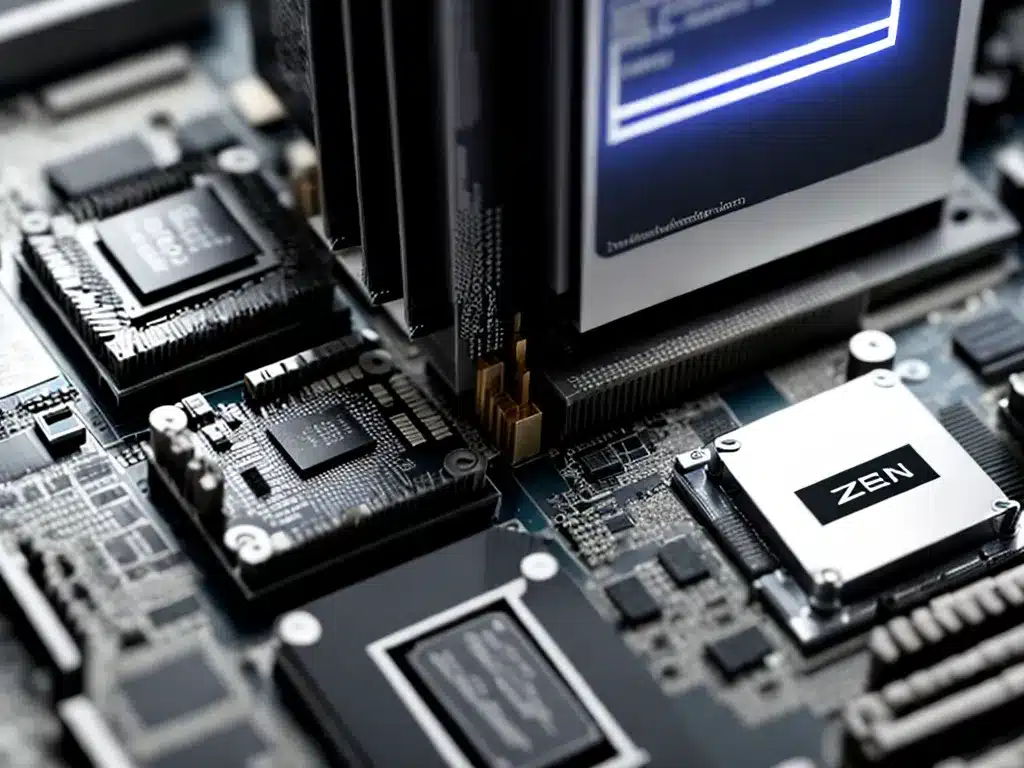

Introduction
The battle between AMD and Intel to produce the fastest CPU cores continues with AMD’s upcoming Zen 4 architecture. As I compare Zen 4 to the previous generation Zen 3, there are some key improvements that will provide significant performance gains. In this article, I will dive deep into the architectural changes and explore how the instruction per clock (IPC) enhancements will impact real-world performance.
Zen 4 Overview
AMD’s next-generation Zen 4 CPU architecture will be built on an optimized 5nm process node. This alone provides increased transistor density and power efficiency over the 7nm Zen 3 design. However, Zen 4 also incorporates major architecture changes that will boost performance.
Key Zen 4 Improvements
- New Zen 4 cores
- DDR5 memory support
- PCIe 5.0 interface
- Enhanced SMT technology
With an expected launch in late 2022, Zen 4 processors will power the next generation of Ryzen desktop CPUs, EPYC data center processors, and more. The architectural improvements will bring IPC gains, allowing Zen 4 cores to do more work per clock cycle.
Enhanced Core Design
One of the most significant changes with Zen 4 is the redesigned core architecture. AMD has focused on boosting IPC through smarter branch prediction, opportunistic data prefetching, and increased execution resources.
Branch Prediction
Branch prediction accuracy is vital for keeping a processor’s execution units fully fed with instructions. Zen 4 incorporates a redesigned branch prediction unit that improves prediction accuracy over Zen 3. With fewer wasted cycles from mispredicted branches, the overall IPC increases.
Opportunistic Data Prefetching
Zen 4 also adds opportunistic data prefetchers that can anticipate data needs and start loading required data into caches sooner. This reduces stall cycles waiting for data retrieval, allowing instructions to execute faster.
Execution Resources
AMD has increased the execution resources per core in Zen 4. With added schedulers and more load/store units, the cores can process more instructions simultaneously. Combined with the prefetching improvements, the extra resources can be kept busier leading to higher IPC.
DDR5 Memory Support
One of the most anticipated changes with Zen 4 is the support for next-generation DDR5 memory. This provides a major bandwidth boost over DDR4 with speeds starting at 4800 MT/s up to an incredible 6400 MT/s.
Faster Bandwidth
With nearly double the bandwidth of DDR4-3200 memory, DDR5 removes memory bottlenecks. Latency is also improved despite running at higher densities with advanced ECC. This results in much higher memory throughput.
Increased Capacities
DDR5 also allows for higher per DIMM capacities, starting at 16GB modules and going up to 64GB. With 8 channels, Zen 4 platforms will support enormous memory configurations up to 512GB. This benefits professional workloads and applications demanding large datasets.
Improved Power Efficiency
Even while providing more performance, DDR5 implements internal voltage regulators for improved power efficiency. The cycles spent transferring data to and from memory will consume less power compared to legacy DDR4 configurations.
PCI Express 5.0 Interface
Another major platform upgrade is the transition to PCIe 5.0 for much higher bandwidth to storage drives and add-in cards.
Faster NVMe Storage
Zen 4 will leverage PCIe 5.0 to provide speeds up to 128GB/s to next-generation NVMe SSDs. This is double the throughput of PCIe 4.0, slashing storage bottlenecks and load times.
Higher Speed Add-in Cards
GPUs and other add-in cards will also benefit from PCIe 5.0’s 32GT/s transfer speeds. Multi-GPU compute tasks will be able to utilize the full bandwidth for demanding workloads. This keeps the data flowing faster than ever.
Backwards Compatibility
While designed for PCIe 5.0 devices, Zen 4 platforms will remain backwards compatible with older PCIe 4.0 and 3.0 hardware. However, to take full advantage of the enhanced bandwidth, PCIe 5.0 devices will be required.
Enhanced SMT Technology
Simultaneous Multi-Threading (SMT) has been improved in Zen 4 allowing for better utilization of the execution units. Whereas Zen 3 cores shared certain resources between threads, Zen 4 adds more duplicate hardware to reduce resource contention. By giving each thread its own resources, overall throughput is increased, especially in highly threaded workloads. AMD is also tweaking the SMT scheduling algorithms to further optimize performance.
Putting It All Together
With the architectural enhancements focused on boosting IPC, Zen 4 is shaping up to be a major upgrade over Zen 3. While final clocks speeds have yet to be announced, the leaked benchmarks are very promising. Given the same clock speeds, Zen 4 delivers significantly higher performance thanks to the combination of the advanced 5nm process node and smarter core design.
Real-World Performance Expectations
Based on everything we know so far about Zen 4, I expect impressive gains in both single and multi-threaded workloads. Here are some examples of what actual performance improvements we might see:
- Up to 15% higher FPS in games limited by single-thread performance
- 25% faster completion on code compilation tasks using all threads
- 30% reduction in 4K video render times due to higher core performance
- 2x improvement in transfer speeds when using PCIe 5.0 SSDs
- 10% faster performance in memory intensive applications due to DDR5
Of course, we’ll have to wait for official benchmarks to know for sure. But with architectural IPC gains and major platform upgrades, Zen 4 is poised to be AMD’s highest performing client CPU yet. I can’t wait to get my hands on a Zen 4 system later this year!
Conclusion
With a redesigned 5nm core architecture focused on improving IPC, the arrival of DDR5 memory, and an upgraded PCIe 5.0 interface, Zen 4 will provide significant performance improvements over Zen 3. AMD is pushing the envelope again with its next-generation CPU design. Based on the details explored in this article, I expect Zen 4 to deliver excellent gains in both desktop and data center environments. One thing is for sure – the competition between AMD and Intel is heating up again, which is great news for consumers looking for more CPU performance.












